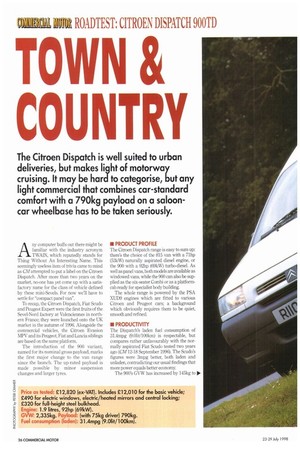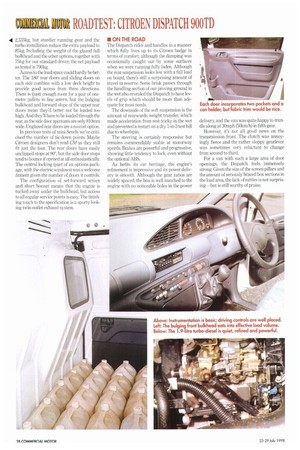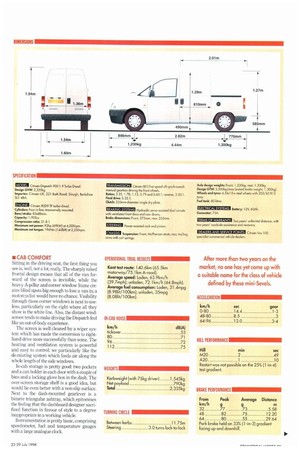111 ROADTEST: CITROEN DISPATCH 900TD
Page 28

Page 30

Page 31

Page 32

If you've noticed an error in this article please click here to report it so we can fix it.
TOWN 8i COUNTRY
The Citroen Dispatch is well suited to urban deliveries, but makes light of motorway cruising. It may be hard to categorise, but any light commercial that combines car-standard comfort with a 790kg payload on a salooncar wheelbase has to be taken seriously.
Any computer buffs out there might be familiar with the industry acronym TWAIN, which reputedly stands for Thing Without An Interesting Name. This seemingly useless item of trivia came to mind as CM attempted to put a label on the Citroen Dispatch. After more than two years on the market, no-one has yet come up with a satisfactory name for the class of vehicle defined by these mini-Sevels. For now well have to settle for "compact panel van".
To recap, the Citroen Dispatch, Fiat Scudo and Peugeot Expert were the first fruits of the Sevel-Nord factory at Valenciennes in northern France; they were launched onto the UK market in the autumn of 1996. Alongside the commercial vehicles, the Citroen Evasion NIPV and its Peugeot, Fiat and Lancia siblings are based on the same platform.
The introduction of the 900 variant, named for its nominal gross payload, marks the first major change to the van range since the launch. The up-rated payload is made possible by minor suspension changes and larger tyres. • PRODUCT PROFILE The Citroen Dispatch range is easy to sum up: there's the choice of the 815 van with a 71hp (53kW) naturally aspirated diesel engine, or the 900 with a 92hp (69kW) turbo-diesel. As well as panel vans, both models are available as windowed vans, while the 900 can also be supplied as the six-seater Combi or as a platformcab ready for specialist body building.
The whole range is powered by the PSA XUD9 engines which are fitted to various Citroen and Peugeot cars; a background which obviously requires them to be quiet, smooth and refined.
• PRODUCTIVITY The Dispatch's laden fuel consumption of 31.4mpg (9.0lit/100km) is respectable, but compares rather unfavourably with the normally aspirated Fiat Scudo tested two years ago (CM 12-18 September 1996). The Scudo's figures were 3mpg better, both laden and unladen, contradicting our usual findings that more power equals better economy.
The 900's GVW has increased by 145kg to
41 2,335kg, hut sturdier running gear and the turbo installation reduce the extra payload to 85kg. Including the weight of the glazed full bulkhead and the other options, together with 75kg for our standard driver, the net payload as tested is 790kg.
Access to the load space could hardly be better. The DU rear doors and sliding doors on each side combine with a low deck height to provide good access from three directions. There is (just) enough room for a pair of onemetre pallets in line astern, but the bulging bulkhead and forward slope of the upper rear doors mean they'd better not be loaded too high. And they'll have to be loaded through the rear, as the side door apertures are only 810mm wide. Unglazed rear doors area no-cost option.
In previous tests of mini-Sevels we've criticised the number of tie-down points. Maybe Citroen designers don't read CM as they still fit just the four. The rear doors have easily unclipped stops at 90, but the side door stops tend to bounce if opened at all enthusiastically. The central locking (part of an options package, with the electric windows) was a welcome fitment given the number of doors it controls.
The configuration of set-forward screen and short bonnet means that the engine is tucked away under the bulkhead, but access to all regular service points is easy. The finishing touch to the specification is a sporty looking twin-outlet exhaust system.
• ON THE ROAD
The Dispatch rides and handles in a manner which fully lives up to its Citroen badge in terms of comfort, although the damping was occasionally caught out by some surfaces when we were running fully laden. Although the rear suspension looks low with a full load on board, there's still a surprising amount of travel in reserve. Some brisk passes through the handling section of our proving ground in the wet also revealed the Dispatch to have levels of grip which should be more than adequate for most needs.
The downside of the soft suspension is the amount of rearwards weight transfer, which made acceleration from rest tricky in the wet and prevented a restart on a dry 1-in-3 test hill due to wheelspin.
The steering is certainly responsive but remains commendably stable at motorway speeds. Brakes are powerful and progressive, showing little tendency to lock, even without the optional ABS As befits its car heritage, the engine's refinement is impressive and its power delivery is smooth. Although the gear ratios are widely spaced, the box is well matched to the engine with no noticeable holes in the power delivery, and the van was quite happy to trundle along at 30mph (50km/h) in fifth gear.
However, it's not all good news on the transmission front. The clutch was annoyingly fierce and the rather sloppy gearlever was sometimes very reluctant to change from second to third, For a van with such a large area of door openings, the Dispatch feels immensely strong. Given the size of the screen pillars and the amount of seriously braced box sections in the load area, the lack of rattles is not surprising—but is still worthy of praise.
• CAB COMFORT Sitting in the driving seat, the first thing you see is, well, not a lot, really. The sharply raked frontal design means that all of the van forward of the screen is invisible, while the heavy A-pillar and corner window frame creates blind spots big enough to lose a van in; a motorcyclist would have no chance. Visibility through those corner windows is next to usele&s, particularly on the right where all they show is the white line. Also, the distant windscreen tends to make driving the Dispatch feel like an out-of-body experience.
The screen is well cleaned by a wiper system which has made the conversion to righthand drive more successfully than some. The heating and ventilation system is powerful and easy to control; we particularly like the de-misting system which feeds air along the whole length of the side windows.
In-cab storage is pretty good: two pockets and a can holder in each tio(w with a couple of bins and a locking glove box in the dash. The over-screen storage shelf is a good idea, but would be even better with a non-slip surface. Next to the dash-mounted gearlever is a bizarre triangular ashtray, which epitomises the feeling that the dashboard designer sacrificed function in favour of style to a degree inappropriate in a working vehicle.
Instrumentation is pretty basic, am-prising speedometer, fuel and temperature gauges with a large analogue clock. .4 Most of the driving controls are well placed, but the roofmounted electric window controls take some getting used to. The windows have one-touch operation in both directions, although this facility is sensibly disabled for safety reasons when the engine is not running. A right-hand parking brake is fitted which allows easy access to the rear in examples without the full bulkhead. A good quality Blaupunkt RDS radio cassette unit was fitted—and much appreciated.
Seats are trimmed in a pleasant fabric which would have broken up the large expanse of plastic if it had been carried over to the door panels. The driver's seat is comfortable with an armrest on the left and very supportive backrest sides, but proved a bit narrow for CM'S sturdier staffers. There was also an annoying intermittent squeak from a spring somewhere in the seat's innards. The dual passenger seat proved to be wide enough for two, but the centre occupant soon tired of trying to find a home for his legs.
Although a bit of squeeze, cross-cab access is possible thanks to the dash-mounted gear
lever. The outer occupants have height-adjustable three-point seat-belts, while the centre seat makes do with a lap-belt. An airbag for the driver is available only as an option. The Dispatch's cab is commendably free of mechanical noise, but wind and tyre noise can be a problem at times.
The drop-down immobiliser keypad is a pain—literally—if you forget it's there and hit it with your knee. We question the value of a system which requires such an irritating degree of input at each restart that the driver is tempted to leave the engine running during brief delivery stops. On the subject of irritants, the bulkhead has a coat hook fitted next to the driver's left shoulder which, if used, acts as a simple but annoying indicator of body roll during cornering.
• SUMMARY The Dispatch's easy all-round access to a payload genuinely in
excess of three-quarters of a tonne, based on the roadspace of a medium saloon car, makes it an ideal city van. But its talents don't end at the city limits, as the power and refinement of its turbo-diesel make it just as much at home on motorways. Apart from its poor forward visibility, driving the Dispatch should present little challenge to the most timid of car drivers.
The Citroen is slightly higher priced than the identical products from Peugeot and Fiat but has a standard warranty and assistance pack. age for two years rather than their one year.
Pi by Colin Barnett Price as tested: £12,820 (ex-VAT). Includes £12,010 for the basic vehicle; £490 for electric windows, electric/heated mirrors and central locking; £320 for full-height steel bulkhead.
Engine: 1.9 litres, 92hp (69k WI.
2,335kg. Payload: (with 75kg driver) 790kg. Fuel consumption (laden): 31.4nnpg (9.014/100km).
SPECIFICATION
ern Citroen Dispatch 900 1 9 Turbo Diesel. Design GVW: 2,335kg.
Imparter: C treen UK, 221 Bath Road, Slough, Berkshire SL1 4BA.
FNC7INE
Citroen XUD9 IF turbo-diesel, Cylinders: Four in line, transversely mounted. Bore/stroke: 83x88mm.
Capacity: 1,905er.
Compression ratio: 21.8:1 Maximum net power. 92hp (69kW) at 4,000rpm. Maximum net torque: 196Nm (1451b1t) at 2,250rpm. TRANSMISSION. Citroen 8E3 five-speed oll-synchromesh manual gearbox driving the front wheels.
Ratios: 3.25, 1 78, 1.12, 0.79 and 0.60:1; reverse, 3.50:1. Final drive: 5.35:1.
Clutch: 235mm-diameter single dry plate.
BRAKING SYSTEMS Hydraulic servo-assisted duol circuits with ventilated front discs and rear drums.
Brake dimensions: Front, 275mm; rear, 255mm.
iiMMON Power-assisted rock and pinion.
CHASSIS
Suspension: Front, McPherson struts; rear, trailing arms with coil springs.
Axle design weights: Front, 1,230kg; rear, 1,300kg. Design GTW: 3,500kg (max braked trailer weight, 1.300kg) Wheels and tyres: 6.5.1x15in steel wheels with 205/65 RI5 tyres Fuel tank: 80 litres.
ELECTRICAL SYSTEMS.
Generator: 75A Battery: 12V, 60Ah TERMS OF WARRANTY
Two years' unlimited distance, with two years' roadside assistance and recovery.
DEALERS AND SERVICE POINTS: specalist commercial vehicle dealers.
OPERATIONAL TRIAL RESULTS
Kent test route: 140.6km (65.5km motorway/75.)km A-road).
Average speed: Laden, 63.9km/h (39.7mph); unladen, 72.1km/h (44.8mph). Average Fuel consumption: Laden, 31 4mpg (8.981it/100km); unladen, 35mpg (8.081it/100km).
IN-CAB NOISE
km/h OA)
tickover 53 80 71 96 72
112 75
WEIGHTS
Kerbweight (with 75kg driver) 1,545kg Net payload 790kg
Total 2,335kg
TURNING CIRCLE
Between kerbs 11.75m Steering 3.0 turns lock-to-lock
ACCELERATION
km/h NC gear 0-80 14.4 1-3 48-80 8.5 3 64-96 12.0 3-4
HILL PERFORMANCE
Hill min sec
M20 2 49 A20 1 10
Restart was not possible on the 25% (1-in-4) test gradient.
BRAKE PERFORMANCE From Peak Average Distance
km/h g g m
32 77 73 5.58 48 82 75 12.20 64 80 55 29.64
Park broke held on 33% (1-in-3) gradient facing up and downhill.




































































































